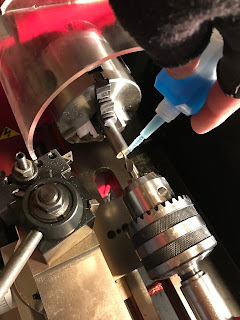 |
| So, using my Sieg mini lathe, a 1/2" bar of cold rolled steel and a 1/4"carbide tipped tool bit, I made a double sided mandrel. |
 |
| Because the cornet is a conical bore instrument, I knew that the bottom inner slide of the main tuning slide would measure smaller than the top inner slide. The bottom measured in at .456. |
 |
| The top measured larger than the bottom at .458. |
 |
| Here is the finished mandrel on the left. On the right, the two handled roller I will be using to expand the diameter of the main tuning slide tubes. |






